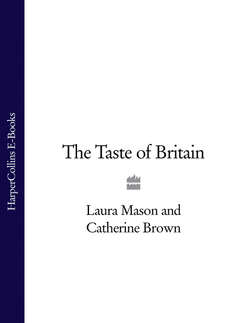Читать книгу The Taste of Britain - Hugh Fearnley-Whittingstall - Страница 14
HISTORY:
ОглавлениеThe name is taken from the village of Cheddar on the southern edge of the Mendips. Points to note are a long history, the apparently consistent excellence of the cheese, a cooperative system for its production, and the way in which the techniques associated with it have spread around the world, though often abused. The name may mislead, however. Although first-class in the parish of Cheddar itself, this cheese was from the outset made throughout the county and the wider region. The name, it is suggested, was attached to the cheese because the fame of Cheddar Gorge defined the district of origin.
Medieval records demonstrate that cheese-making was already undertaken in the region, but more precise information is not forthcoming until the modern period. In the seventeenth century, the communal pooling of milk to make very large truckles was a matter of remark although few of them can have been as large as the cheese made for Lord Weymouth that ‘was big enough to hold a girl of 13’. All the milk was contributed to a common dairy, or ‘cheddar club’ which meant each cheese could be much larger than those from small, individual herds, so making them fit for long maturing, which accounts for their excellent flavour. This set Cheddar cheese apart from much of the competition. Already, by 1662, they were ‘so few and so dear [that they are] hardly to be met with, save at some great man’s table’ (Rance, 1982). The system was also sufficiently scouted to be hinted at in a play by Aphra Behn in the late seventeenth century. Its high reputation continued. Rance notes that in the early eighteenth century, Cheddar was described as ‘the most noted place in England for making large, fine, rich and pleasant cheese’ and that milk was brought into the common dairy and the quantities noted down in a book kept for the purpose. Profit from selling cheese was given back in proportion to the amount of milk each person contributed. Cooperative cheese-making continued until the First World War. Cheeses were indeed very large, weighing 90-120 pounds (45-60kg); cheeses of up to one and a half hundredweight (about 90kg) were noted in Law’s Grocer’s Manual in the late nineteenth century.
Detailed accounts of the Cheddar method date from an agricultural report of the late eighteenth century, but an exact recipe was not written down (or has not survived) for another 50 years. None the less, the routines associated with the cheese may have spread beyond the region earlier than this implies. Improvements in agriculture in the late nineteenth century benefited the cheese-makers, who made advances in both techniques and equipment, including the invention of the cheese mill and careful work on time, temperature and hygiene. Once perfected, the method became so identified with the cheese that it was known as ‘cheddaring’. This was generously exported around the world by the British, who left a trail of upstart ‘Cheddars’ whenever they colonized an area deemed suitable for production.
The centralization of cheese-making during 1939-45 had significant effects on Cheddar. Firstly, official requirements for cheese to be of a specified moisture content (to enhance keeping qualities) led to the elimination of moister types. Secondly, the number of farms who resumed production after the war was greatly reduced. The introduction of rindless, block cheeses and frequent use of pasteurized milk further reduced the unique characteristics of Cheddar made in South Western England. Proliferation of soi-disant Cheddars blurred the popular concept of the real thing.
Farmhouse cheese-making survives in the area, although some of the operations are semi-industrial in scale. Some makers still use unpasteurized milk to make truckle cheeses. A recent development is the introduction of rennet of vegetable origin, to cope with the increased demand for vegetarian foods.
The designation Cheddar is unprotected, and much inferior cheese is made elsewhere under this name. ‘West Country Farmhouse Cheddar Cheese’ has been awarded Protected Designation of Origin (PDO).
